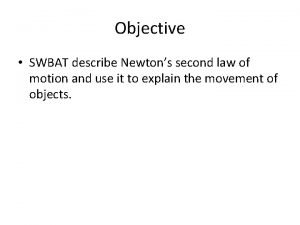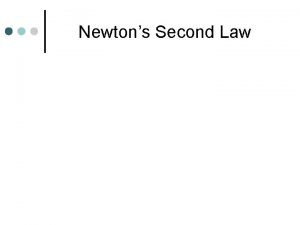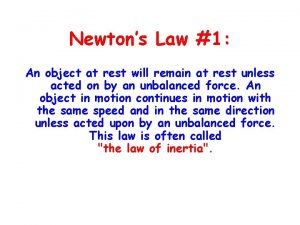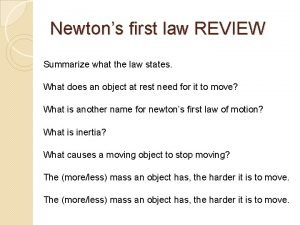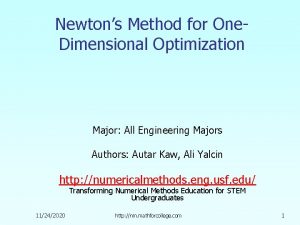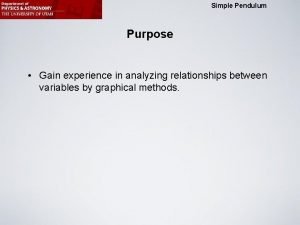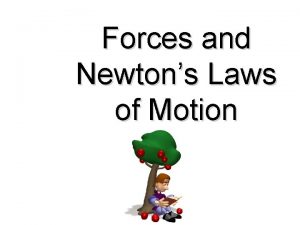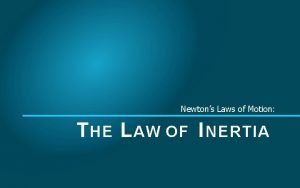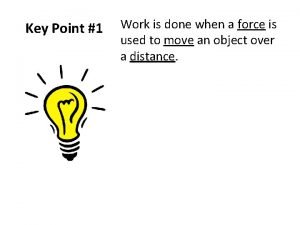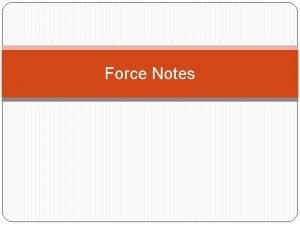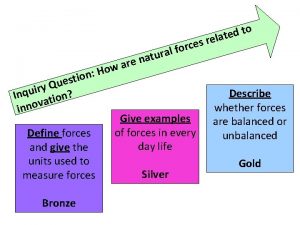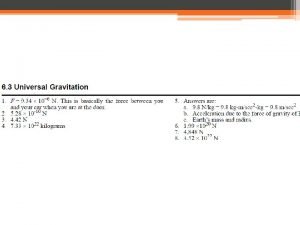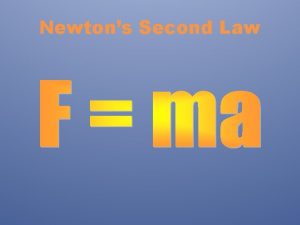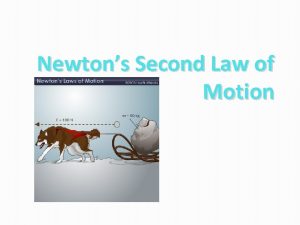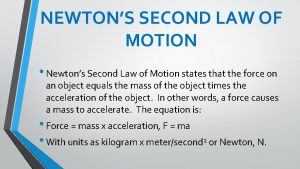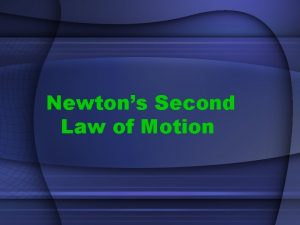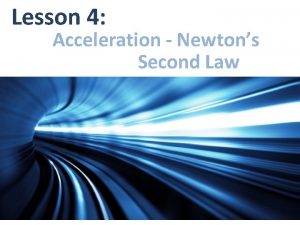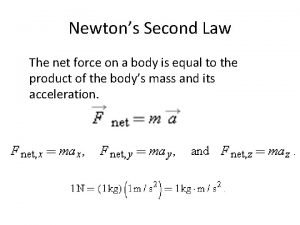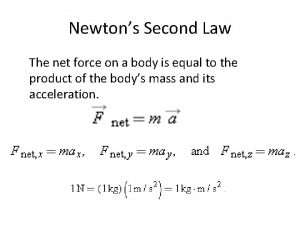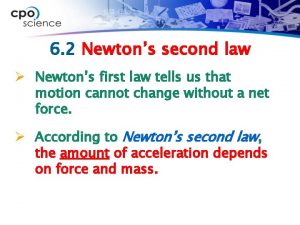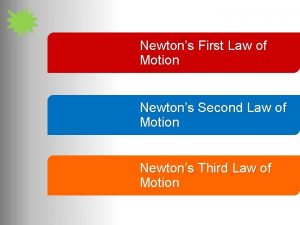Newtons second law Newtons second law Net force



















- Slides: 19

Newton’s second law

Newton’s second law Net force (N) Acceleration(m /s 2) Mass (kg) The acceleration of an object equals the net force divided by the mass.

Direction of force and acceleration Acceleration and force are vectors.

Test your knowledge A student drags a 10 kg box across a rough level floor with a constant velocity of 1. 5 m/s. What is the net force on the box?

Test your knowledge A student drags a 10 kg box across a rough level floor with a constant velocity of 1. 5 m/s. What is the net force on the box? The net force on the box is zero!

Units The second law can help you remember the definition of a newton. Always use mass in kilograms and acceleration in m/s 2 when applying Newton’s second law.

Finding motion from forces If you know the force on an object, you can predict changes in its motion. A 0. 25 kg ball is traveling 40 m/s to the right when it is hit with a force of 3, 000 N for 0. 005 seconds. What is its final velocity?

Steps A 0. 25 kg ball is traveling 40 m/s to the right when it is hit with a force of 3, 000 N for 0. 005 seconds. What is its final velocity? 1. Use force and mass to find acceleration through the second law. 2. Use the acceleration to find the change in velocity or position.

Solution A 0. 25 kg ball is traveling 40 m/s to the right when it is hit with a force of 3, 000 N for 0. 005 seconds. What is its final velocity? 1. Use force and mass to find acceleration through the second law. Impacts can cause very large accelerations for short times!

Solution A 0. 25 kg ball is traveling 40 m/s to the right when it is hit with a force of 3, 000 N for 0. 005 seconds. What is its final velocity? 1. Use force and mass to find acceleration through the second law. 2. Use the acceleration to find the change in velocity or position. The ball reverses direction!

Finding forces from motion If you know the acceleration of an object, you can determine the net force acting on it. A 70, 000 kg aircraft reaches a takeoff velocity of 67 m/s (150 mph) in 11 seconds. Calculate the minimum force required from the engines.

Steps A 70, 000 kg aircraft reaches a takeoff velocity of 67 m/s (150 mph) in 11 seconds. Calculate the minimum force required from the engines. 1. Use velocity, distance, and time find the acceleration. 2. Use the acceleration and mass to find the force.

Solution A 70, 000 kg aircraft reaches a takeoff velocity of 67 m/s (150 mph) in 11 seconds. Calculate the minimum force required from the engines. 1. Use velocity, distance, and time find the acceleration.

Solution A 70, 000 kg aircraft reaches a takeoff velocity of 67 m/s (150 mph) in 11 seconds. Calculate the minimum force required from the engines. 1. Use velocity, distance, and time find the acceleration. 2. Use the acceleration and mass to find the force. This is almost 2/3 of the aircraft’s weight!

Assessment A 10 kg object is subject to a net force of 25 N. What is the acceleration of the object in m/s 2?

Assessment A 10 kg object is subject to a net force of 25 N. What is the acceleration of the object in m/s 2? The second law says a = F/m. Therefore a = 25 N /10 kg = 2. 5 m/s 2 If the object starts at rest, then how long will it be before its velocity is 25 m/s?

Assessment A 10 kg object is subject to a net force of 25 N. What is the acceleration of the object in m/s 2? The second law says a = F/m. Therefore a = 25 N /10 kg = 2. 5 m/s 2 If the object starts at rest, then how long will it be before its velocity is 25 m/s? You know that v = v 0 + at and v 0= 0. Rearranging gives t = v/a = (25 m/s) / (2. 5 m/s 2) = 10 seconds.

Assessment What is the minimum force required to increase the speed of a 1, 000 kg vehicle by 10 m/s in 3 seconds?

Assessment What is the minimum force required to increase the speed of a 1, 000 kg vehicle by 10 m/s in 3 seconds? F = ma = (1, 000 kg)( 10 m/s / 3 s) = 3, 333 N
 Newton's second law in soccer
Newton's second law in soccer Describe newtons second law
Describe newtons second law What's newtons second law of motion
What's newtons second law of motion Newton 2nd law
Newton 2nd law Newtons second law
Newtons second law Newtons second law example
Newtons second law example Mustafa sheikh lawyer
Mustafa sheikh lawyer Newton's first law and second law and third law
Newton's first law and second law and third law Newton's first law
Newton's first law Newtons second kaw
Newtons second kaw Newtons second kaw
Newtons second kaw Pendulum purpose
Pendulum purpose Newtons first lw
Newtons first lw Example of law of action and reaction
Example of law of action and reaction Newtons second aw
Newtons second aw Angela uses a force of 25 newtons
Angela uses a force of 25 newtons A 25 newton horizontal force northward
A 25 newton horizontal force northward Lift a pencil case force in newtons
Lift a pencil case force in newtons This machine is frictionless
This machine is frictionless Newtons 3 rd law of motion
Newtons 3 rd law of motion

